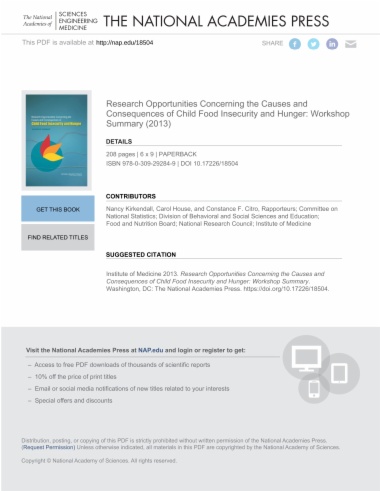

Section 141 of The Healthy, Hunger-Free Kids Act of 20101 provides funding for a research program on the causes and consequences of childhood hunger and food insecurity, and the characteristics of households with childhood hunger and food insecurity, with a particular focus on efforts to improve the knowledge base regarding contributing factors, geographic distribution, programmatic effectiveness, public health and medical costs, and consequences for child development, well-being, and educational attainment. The Economic Research Service and Food and Nutrition Service of the US Department of Agriculture conducted two outreach efforts to obtain input from the research community and other stakeholders to help focus on areas and methods with the greatest research potential. First, Food and Nutrition Service sought written comments to selected questions through publication of a Federal Register Notice. The second option was to convene a workshop under the auspices of the Committee on National Statistics of the National Research Council and the Food and Nutrition Board of the Institute of Medicine.
Research Opportunities Concerning the Causes and Consequences of Child Food Insecurity and Hunger is the summary of that workshop, convened in Fall 2012 to examine research gaps and opportunities to advance understanding of the causes and consequences of child hunger in the United States. This report reviews the adequacy of current knowledge, identifies substantial research gaps, and considers data availability of economic, health, social, cultural, demographic, and other factors that contribute to childhood hunger or food insecurity. It also considers the geographic distribution of childhood hunger and food insecurity; the extent to which existing federal assistance programs reduce childhood hunger and food insecurity; childhood hunger and food insecurity persistence, and the extent to which it is due to gaps in program coverage; and the inability of potential participants to access programs, or the insufficiency of program benefits or services.
Research Opportunities Concerning the Causes and Consequences of Child Food Insecurity and Hunger will be a resource to inform discussions about the public health and medical costs of childhood hunger and food insecurity through its focus on determinants of child food insecurity and hunger, individual, community, and policy responses to hunger, impacts of child food insecurity and hunger, and measurement and surveillance issues.